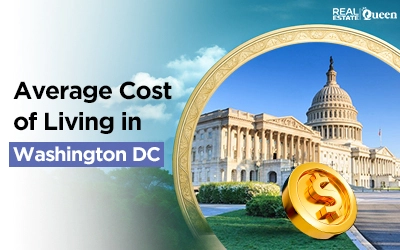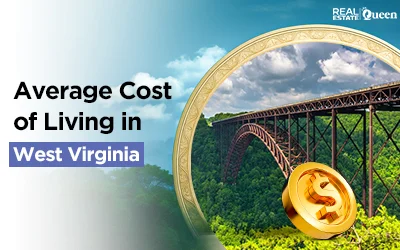
Considering a move to North Dakota? This state offers much more than prairies and friendly towns. With its strong economy and lively cities, the average cost of living in North Dakota makes settling here an easy choice.
North Dakota’s cost-of-living index for 2025 is 88.6. Therefore, residents pay about 11.4% less than the national average. As a result, your money stretches further in cities like Fargo, Williston, or Minot. Here’s a look at North Dakota’s average cost of living across housing, utilities, and essentials.
TL;DR: Average Cost of Living in North Dakota 2025
- Cost of living index: 88.6 (11.4% below US average)
- Required income for middle-class life: $41,148 after tax
- Average monthly rent: $1,080 across the state
- Median home price: $295,000
- Utility costs: $396–$556 per month
- Average salary: $60,570 per year
- Monthly groceries: $265 per person
- Annual healthcare: $3,828 per person
Understanding North Dakota’s Cost of Living
The average cost of living in North Dakota is appealing to most people. For example, with an after-tax income of $41,148, you can live well almost anywhere in the state.
Salaries are strong. Average annual earnings reach $60,570. Median salaries come in at about $50,320.
Typical monthly expenses include:
- Rent (1–2 bedroom): $967–$1,196
- Utilities: $396–$556
- Groceries: $265
- Fuel prices at or below the US average
- Healthcare: $319/month, about $3,828/year
- Childcare: Moderate
Meanwhile, the average cost of living in North Dakota can be higher in Fargo or Bismarck. However, Minot and Dickinson often offer better deals.
Housing and Rental Market in North Dakota
North Dakota’s housing market truly stands out for its affordability. For example, the average rent is $1,080 per month. This is cheaper than Minnesota ($1,329), Montana ($1,409), and South Dakota ($1,200). On the other hand, Iowa has a slightly lower rent at $961.
The median home price is about $295,000. Therefore, it’s well below the numbers in Montana and Minnesota.
Peer State Comparison:
- South Dakota: Rent +11.1% higher; Home price +14.6% higher
- Minnesota: Rent +23.1% higher; Home price +23.2% higher
- Montana: Rent +30.5% higher; Home price +51.5% higher
- Iowa: Rent -11.0% lower; Home price -8.5% lower
Fargo and Bismarck have strong demand. As a result, prices are somewhat elevated. Meanwhile, Grand Forks and Williston offer more affordable choices.
👉 Looking for homes for sale in North Dakota that match your budget? Discover the latest listings with advanced search filters and sorting options on Houzeo, America’s best home buying website.
Utilities and Other Expenses in North Dakota
Utility costs in North Dakota are lower than in many neighboring states. Average utility bills run from $396 to $556 each month. Electric rates are about $142. This is slightly below Minnesota and similar to South Dakota and Iowa.
State-by-state utility comparisons:
- North Dakota: $396–$556, electric $142
- South Dakota: $408–$551, electric $125
- Minnesota: $400+, electric $193
- Montana: $548, electric $108
- Iowa: $507, electric $152
Groceries average $265 per person every month. For example, this cost is just above regional averages but still manageable.
Transport is affordable. Gas prices are at or below the national averages. In addition, most towns offer low transit fares.
Healthcare premiums for a basic plan are $319 per month. As a result, North Dakota compares well to neighboring states.
More living costs:
- Groceries: ND $265, SD $256, MN $251, MT $246, IA $227
- Healthcare: ND $319/mo, SD $408/mo, MN $315/mo, MT $400+/mo, IA $321/mo
Income and Job Market in North Dakota
North Dakota’s job market delivers good salaries. Average pay is $60,570, and the median is $50,320.
Most families find the average cost of living in North Dakota sustainable. On the other hand, Minnesota pays more ($66,000–$69,000), but the living costs are also higher.
Fargo and Bismarck lead the job market, especially in tech, health care, and education.
Is North Dakota Worth the Average Cost?
North Dakota’s real value lies in affordable housing and stable utilities. In addition, cities like Fargo and Bismarck are adding new amenities quickly.
Families benefit from moderate daycare and preschool fees. Therefore, many residents find North Dakota a smart place for savings and quality of life.
Regional Insights and Relocation Tips
If you’re headed to North Dakota, consider the character of local sectors:
- Fargo: Largest city, strong tech/startup scene, top schools, lively downtown.
- Bismarck: Administrative center, healthcare jobs, family-friendly neighborhoods.
- Grand Forks: University town, affordable rent, youthful energy.
- Williston: Booming with energy sector opportunities, fluctuating rents.
Each metro brings unique prospects, from college apartment hunting to executive relocation packages.
For relocating families, research local school districts and leverage employer relocation programs when possible. Home buyers should work with local agents to navigate competitive but accessible markets.
Conclusion
The average cost of living in North Dakota is inviting for budget-conscious residents. Lower housing prices, steady utilities, and reasonable grocery costs make North Dakota a wise choice. For those looking to stretch their dollars, this state truly stands out in the Midwest.
👉 Start your home search today by exploring the latest North Dakota homes for sale on Houzeo and discover neighborhoods that fit your budget and lifestyle.
FAQs About North Dakota’s Cost of Living
Is North Dakota more affordable than nearby states?
Yes, North Dakota is more affordable than nearby states. The cost of living in North Dakota is about 11% below the US average and lower than in Montana, South Dakota, and Minnesota.
What is the average monthly rent in North Dakota?
The average monthly rent in North Dakota is around $1,080, which is considerably lower than in most neighboring states.
How much do you need to earn to live well in North Dakota?
You need an after-tax income of about $41,148 to live well in this state. The average salary in North Dakota is above $60,000, supporting a comfortable lifestyle.
Are utilities and groceries expensive in North Dakota?
No, utilities and groceries in North Dakota are not expensive. Utility bills are generally lower than in nearby states, and grocery costs are close to the national average.
Is North Dakota suitable for families?
Yes, North Dakota is suitable for families. Daycare and preschool costs are moderate, and the state offers many family-friendly towns and safe communities.






